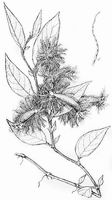
Trichantha minor Hook., type species = Columnea minor (Hook.) Hanst.
Hook.f., Icon. pl., t. 666 (1844).
= Columnea sect. Ortholoma Benth. (see Kvist & Skog 1993).
Full name and orig. publication: : Trichantha Hook. f., Icon. pl. 3: tab. 666 (July 1844).
Etymology: From the Greek τριχος, trichos = hair, and άνθη, anthē, ανθος, anthos = flower; alluding to the copious and long hairs covering the flower.
Synonyms: Columnea sect. Trichantha (Hook.) Kuntze (1904), Ortholoma (Benth.) Hanst. (1854), Columnea sect. Ortholoma Benth. (1846), Columnea subg. Ortholoma (Benth.) Hanst. (1854), Stenanthus Oerst. ex Hanst. (1854), Pterygoloma Hanst. (1854), Columnea sect. Pterygoloma (Hanst.) Fritsch (1894), Columnea sect. Systelostoma Benth. (1876).
Description: Epiphytic suffruticose, mostly vining, spreading or scandent plants. Stem erect, decumbent or pendent. Leaves opposite, usually anisophyllous, somewhat fleshy, coriaceous or chartaceous. Axillary cymes 1- to several-flowered. Sepals laciniate, serrate or entire. Corolla tubular, straight, sometimes inflated, limb of subequal lobes or strongly bilabiate or dorsal lobes connate to form a galea (then tube centrally much inflated and distally constricted); sometimes with ± conspicuous appendages, flat, long and narrow emerging either from the sinuses or from the dorsal side of the lobes. Stamen 4, included. Ovary superior Nectary of a single, dorsal, connate gland. Fruit a globose or ovoid berry of pink, red or purple (rarely white) colour.
Chromosome number: 2n = 18.
Species number: Over 70.
Type species: Tichantha minor Hook.f.
Species names (incl. publication and synonyms): See Skog, L.E. & J.K. Boggan. 2005: World checklist of Gesneriaceae: http://persoon.si.edu/Gesneriaceae/Checklist.
Distribution: Along the Western Cordillera from Bolivia to Guatemala, coastal Venezuela, Greater Antilles, the Guayana Highlands, and eastern Brazil, the centre of diversity is Colombia and Panama.
Ecology: Like Columnea.
Notes: Distinct from Columnea s.str. by the non-columneoid corolla and the pollen (oblate-speroidal, with a well-differentiated area around the colpi; similar as in Pentadenia, but apparently because some spp. belonging to Pentadenia were put in Trichantha in the pollen analysis (Smith, pers. comm.). From Dalbergaria it differs in the habit (if fern-frond-shaped, then always combined with long, thin, vining and scandent branches) and the pollen, from Pentadenia by the nectary, from Bucinellina by the corolla shape and the fruit. Hybrids with these taxa are sterile.
Selected references: Morton, Contr. U.S. Natl. Herb. 38: 1-27 (1963), rev.; Wiehler, Selbyana 1: 33 (1975); Kvist & Skog, Allertonia 6: 327-400 (1993), reg. rev. (Ecuador).
Bibliography: See Skog, L.E. & J.K. Boggan. 2005. Bibliography of the Gesneriaceae. 2nd edition: http://persoon.si.edu/Gesneriaceae/Bibliography.
Illustrations:
 |
Trichantha minor Hook., type species = Columnea minor (Hook.) Hanst. Hook.f., Icon. pl., t. 666 (1844). |
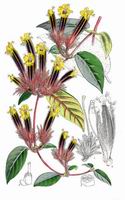 |
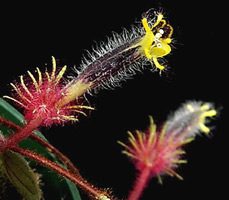 |
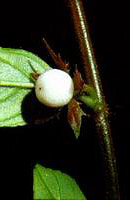 |
Trichantha minor Hook. = Columnea minor (Hook.) Hanst. Left: Bot. Mag. t. 5428 (1864). |
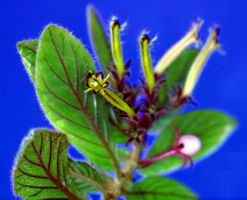 |
Trichantha brenneri Wiehler = Columnea brenneri (Wiehler)
B. Morley
Phot. W. Barthlott (1987) |
last modified: 2007-07-13